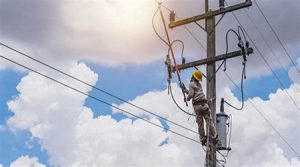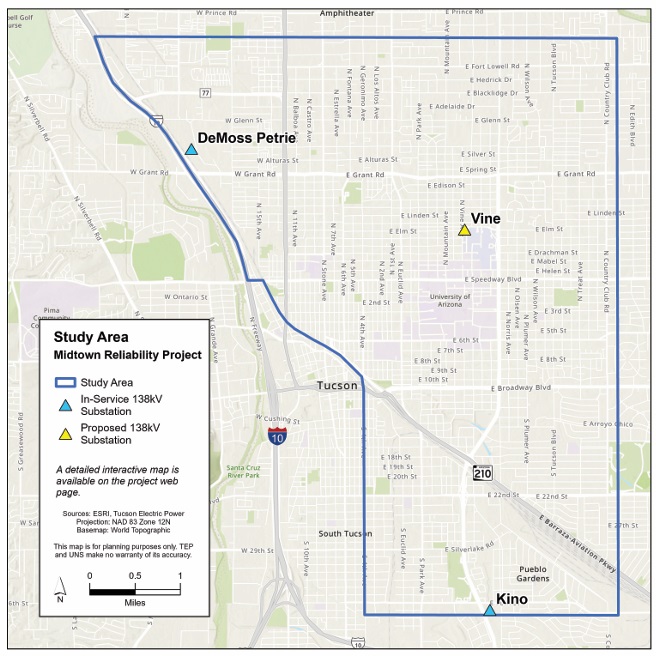ACC Gives the Green Light for TEP’s Midtown Reliability Project
 Phoenix, Ariz. (September 10, 2024)— At the Arizona Corporation Commission’s Regular Open Meeting on September 5, 2024, the Commission voted 5-0 to approve a Certificate of Environmental Compatibility (CEC) for Tucson Electric Power Company’s (TEP) Midtown Reliability Project.
Phoenix, Ariz. (September 10, 2024)— At the Arizona Corporation Commission’s Regular Open Meeting on September 5, 2024, the Commission voted 5-0 to approve a Certificate of Environmental Compatibility (CEC) for Tucson Electric Power Company’s (TEP) Midtown Reliability Project.
The Project needs to upgrade Midtown Tucson’s older, overloaded 46 kV transmission system to a more flexible, higher-voltage one. The Project involves the construction of a new 138 kV transmission line approximately 8.5 miles in length, mounted on steel monopole structures. The Project will loop the existing TEP DeMoss Petrie 138 kV Substation to the existing TEP Kino 138 kV Substation with a connection at the planned Vine 138 kV Substation.
“I understand why some Tucson residents would want this project constructed below ground,” commented Commissioner Myers, “however, constructing the project below ground is not needed for safety, reliability or other utility operational reasons; therefore, is not acceptable for all TEP customers to shoulder the $67 million cost for undergrounding the project.”
“I am pleased the Commission approved this important grid-reliability project, while at the same time protecting TEP customers from unnecessary undergrounding expenses,” stated Commissioner Myers.
The Commission’s vote was consistent with Tucson voters’ rejection of Proposition 412 last year, which included a new customer fee for undergrounding power lines.
The Commission considered several factors in determining whether the project is in the public interest. It concluded that it meets the need for an adequate, economical, and reliable supply of electric power and minimizes the impact on the state’s environment and ecology.
All documents related to this case can be found in the ACC’s eDocket – https://edocket.azcc.gov – under docket number L-00000C-24-01 I 8-00232.
Components include:
• A new transmission line and substation that connect midtown neighborhoods to TEP’s modern 138-kilovolt (kV) system, more than tripling electric capacity in the area.
• Significant investments in distribution systems that link customers’ homes and businesses to the local energy grid.
• Retirement and removal of old equipment, including eight substations and 19 miles of power lines throughout central Tucson, helping keep power bills lower. Because these upgrades are
urgently needed to maintain reliable service, TEP plans to complete construction of the transmission line and substation by the summer of 2027.
Project Needs
TEP’s 46-kV system was designed to serve the energy needs of homes and businesses built in the mid to late 20th century. While many of those buildings remain the same, particularly in central Tucson, their energy use has escalated significantly with a growing population, the use of air conditioning rather than evaporative cooling and greatly expanded use of electronic devices. Some transformers providing service in central Tucson are more than 50 years old, while other elements are even older.
Upgrades are critical because some of this equipment is rated as being in ‘poor’ or ‘very poor’ condition, creating a greater risk of outages. Simply replacing that equipment would be expensive
and ineffective, and would not address the need for additional capacity.
Current Status
In July 2023, TEP defined the Midtown Reliability Project study area boundaries as just north of Fort Lowell Road on the north, just west of Interstate 10 and South Fourth Avenue on the west, just south of East 36th Street on the south, and just east of Country Club Road on the east.

Specific route segments for the proposed transmission line have not yet been developed. TEP has begun a new review of all potential routes for the line, including those previously excluded from consideration as part of the Kino-DeMoss Petrie (DMP) Transmission Line Project.
Help Guide Central Tucson’s Energy Future
Although Arizona law defines the criteria that must be considered when evaluating potential transmission line routes, TEP also wants to hear about other issues and concerns from customers
and stakeholders. TEP will use all these criteria to compare potential transmission line routes and assess their compatibility with the environment and the preferences expressed by
stakeholders.
Midtown Reliability Project Benefits
The Midtown Reliability Project will close our local energy grid’s transmission network gap. Benefits include:
Shorter, less frequent power outages. The project will complete a 138-kV “loop” around central Tucson allowing TEP to supply energy from more than one direction to substations that support service to residents, business owners, community organizations, service providers and other customers in central Tucson.
Greater capacity for growing energy needs.
New 138 kV transmission facilities will provide more than three times the capacity of the current system, enough to meet our community’s day-to-day energy needs for a lifetime. Aging 4-kV facilities will be replaced with new 13.8-kV distribution lines, poles, transformers and switchgear – improvements that depend upon the construction of new 138-kV transmission facilities.
More customer-owned solar and storage.
Transmission and distribution improvements will allow customers in the area to continue adding rooftop solar panels, private battery storage systems, and electric vehicles. Currently, some central Tucson neighborhoods are nearing capacity for solar interconnections. Comparable cost, greater efficiency. Completing the new, higher-capacity transmission line and associated improvements would allow TEP to retire up to eight 46-kV substations and associated facilities within ten years, avoiding approximately $42 million in replacement costs for facilities needing replacement today. Additional 46-kV facilities could be retired soon, avoiding significant additional replacement costs and impacts.
Improved service is citywide.
The Midtown Reliability Project will reduce the strain on TEP’s remaining 46 kV system, helping to avoid overloads in other parts of town.
Support for economic growth and a healthy community. Additional energy capacity will support anticipated job and population density increases that the City expects. The project will also upgrade service to the University of Arizona, Tucson’s largest employer, and Banner-University Medical Center’s Tucson campus and emergency room, each providing services and benefits for our entire community and supporting a growing economy.